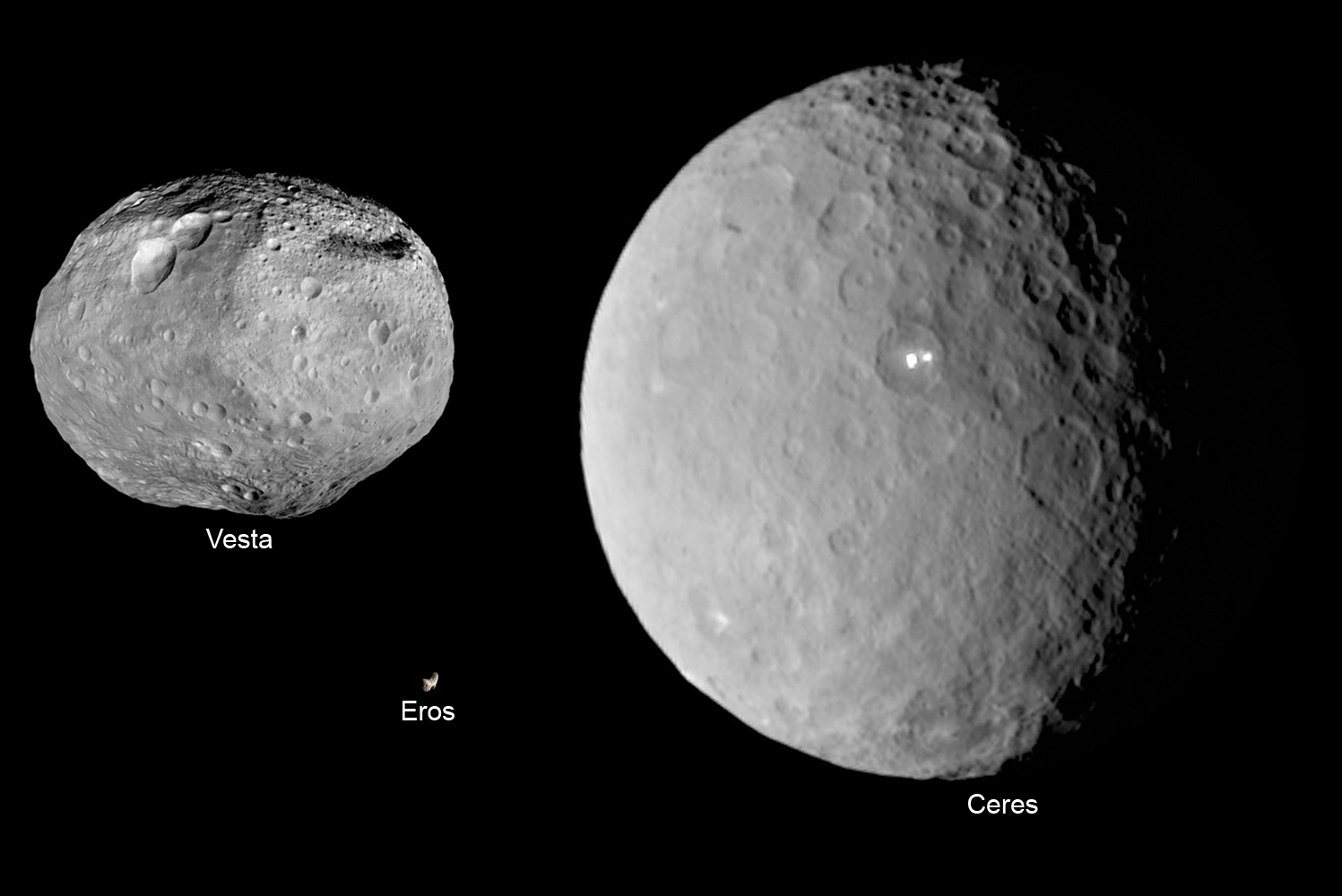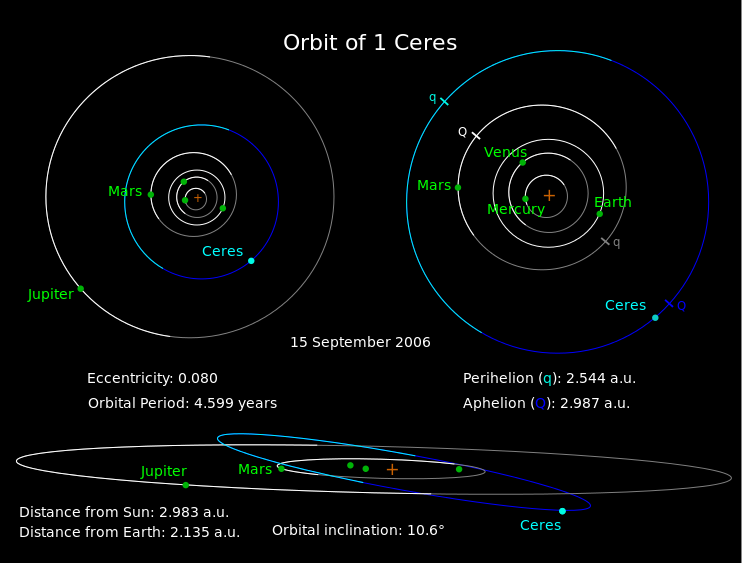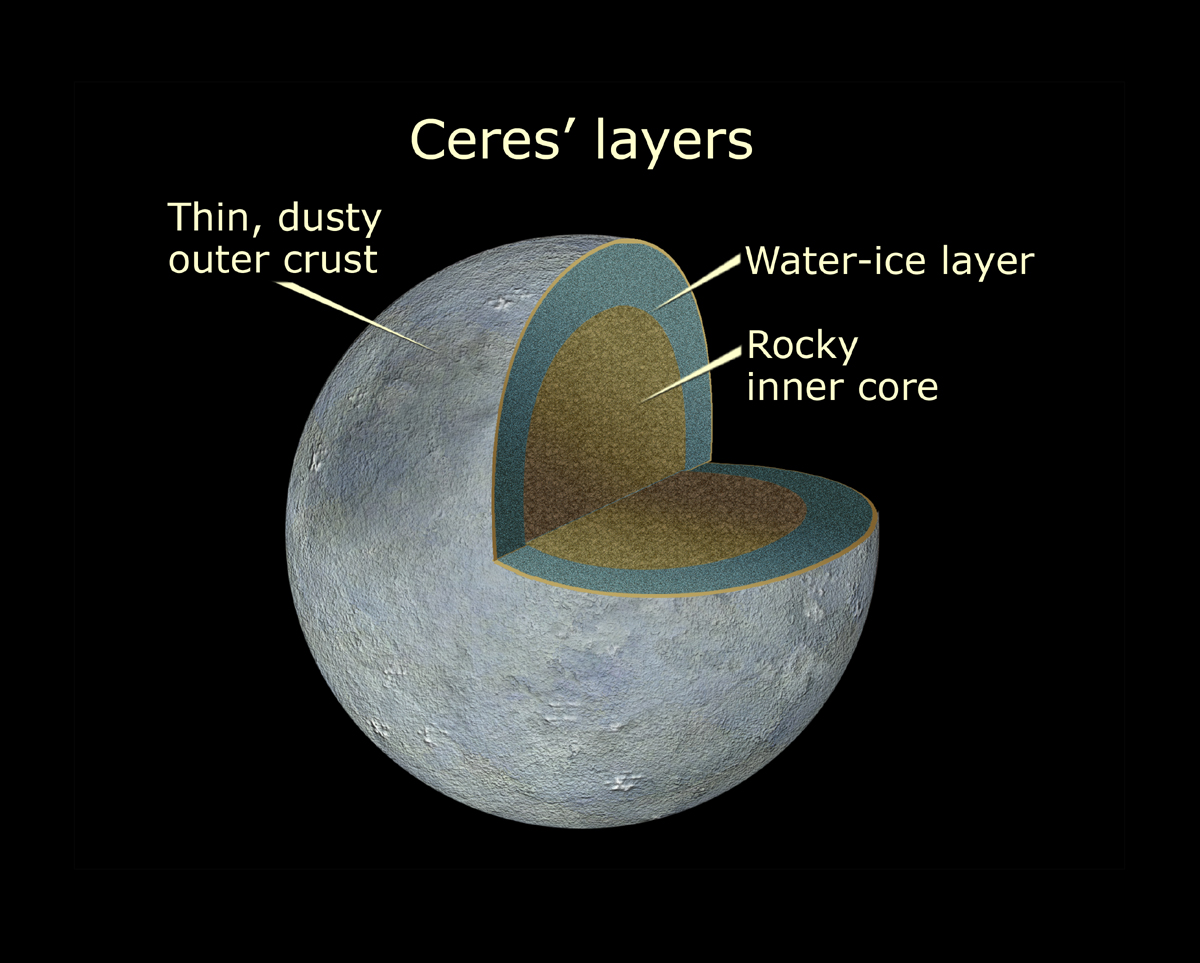- Details
- Last Updated on Wednesday, 28 December 2016 15:36
Ceres Asteroid

Ceres viewed by the Dawn spacecraft on 2015-May-6 at a distance of 13,600 km.
Animation by DAWN http://www.granometry.com/data/2016/PlanetCeres.mp4 .

Size comparison of Vesta, Ceres and Eros

Ceres (/ˈsɪəriːz/; minor-planet designation:1 Ceres) is the largest object in the asteroid belt, which lies between the orbits of Mars and Jupiter. Its diameter is approximately 945 kilometers, making it the largest of the minor planets within the orbit of Neptune. The thirty-third largest known body in the Solar System, it is the only one within the orbit of Neptune that is designated adwarf planet by the International Astronomical Union (IAU). Composed of rock and ice, Ceres is estimated to comprise approximately one third of the mass of the entire asteroid belt. Ceres is the only object in the asteroid belt known to be unambiguously rounded by its own gravity. From Earth, the apparent magnitude of Ceres ranges from 6.7 to 9.3, and hence even at its brightest, it is too dim to be seen with the naked eye, except under extremely dark skies.
Ceres was the first asteroid discovered, by Giuseppe Piazzi at Palermo on 1 January 1801. It was originally considered a planet, but was reclassified as an asteroid in the 1850s when many other objects in similar orbits were discovered.
Ceres appears to be differentiated into a rocky core and icy mantle, and may harbor a remnant internal ocean of liquid water under the layer of ice. The surface is probably a mixture of water ice and various hydrated minerals such as carbonates and clay. In January 2014, emissions of water vapor were detected from several regions of Ceres. This was unexpected, because large bodies in the asteroid belt do not typically emit vapor, a hallmark of comets.
The robotic NASA spacecraft Dawn entered orbit around Ceres on 6 March 2015. Pictures with a resolution previously unattained were taken during imaging sessions starting in January 2015 as Dawn approached Ceres, showing a cratered surface. Two distinct bright spots (or high-albedo features) inside a crater, incorrectly reported as observed in earlier Hubble images, were seen in a 19 February 2015 image, leading to speculation about a possible cryovolcanic origin or outgassing. On 3 March 2015, a NASA spokesperson said the spots are consistent with highly reflective materials containing ice or salts, but that cryovolcanism is unlikely. On 11 May 2015, NASA released a higher resolution image showing that, instead of one or two spots, there are actually several.
Johann Elert Bode, in 1772, first suggested that an undiscovered planet could exist between the orbits of Mars and Jupiter. Keplerhad already noticed the gap between Mars and Jupiter in 1596. Bode based his idea on the Titius–Bode law —a now-discredited hypothesis Johann Daniel Titius first proposed in 1766—observing that there was a regular pattern in the semi-major axes of the orbits of known planets, marred only by the large gap between Mars and Jupiter. The pattern predicted that the missing planet ought to have an orbit with a semi-major axis near 2.8 astronomical units (AU). William Herschel's discovery of Uranus in 1781 near the predicted distance for the next body beyond Saturn increased faith in the law of Titius and Bode, and in 1800, a group headed by Franz Xaver von Zach, editor of the Monatliche Correspondenz, sent requests to twenty-four experienced astronomers (dubbed the "celestial police"), asking that they combine their efforts and begin a methodical search for the expected planet. Although they did not discover Ceres, they later found several large asteroids.
One of the astronomers selected for the search was Giuseppe Piazzi at the Academy of Palermo, Sicily. Before receiving his invitation to join the group, Piazzi discovered Ceres on 1 January 1801. He was searching for "the 87th [star] of the Catalogue of the Zodiacal stars of Mr la Caille", but found that "it was preceded by another". Instead of a star, Piazzi had found a moving star-like object, which he first thought was acomet. Piazzi observed Ceres a total of 24 times, the final time on 1801-Feb-11, when illness interrupted his observations. He announced his discovery on 24 January 1801 in letters to only two fellow astronomers, his compatriot Barnaba Oriani of Milan and Bode of Berlin. He reported it as a comet but "since its movement is so slow and rather uniform, it has occurred to me several times that it might be something better than a comet". In April, Piazzi sent his complete observations to Oriani, Bode, and Jérôme Lalande in Paris. The information was published in the September 1801 issue of the Monatliche Correspondenz.
By this time, the apparent position of Ceres had changed (mostly due to Earth's orbital motion), and was too close to the Sun's glare for other astronomers to confirm Piazzi's observations. Toward the end of the year, Ceres should have been visible again, but after such a long time it was difficult to predict its exact position. To recover Ceres, Carl Friedrich Gauss, then 24 years old, developed an efficient method of orbit determination. In only a few weeks, he predicted the path of Ceres and sent his results to von Zach. On 31 December 1801, von Zach and Heinrich W. M. Olbers found Ceres near the predicted position and thus recovered it.
The early observers were only able to calculate the size of Ceres to within an order of magnitude. Herschel underestimated its diameter as 260 km in 1802, whereas in 1811 Johann Hieronymus Schröter overestimated it as 2,613 km.
Physical characteristics
Ceres has a mass of 9.39×1020 kgas determined from the Dawn spacecraft.With this mass, Ceres comprises approximately a third of the estimated total 3.0 ± 0.2×1021 kg mass of the asteroid belt,which is in turn approximately 4% of the mass of the Moon. The mass of Ceres is large enough to give it a nearly spherical shape in hydrostatic equilibrium.Among Solar System bodies, Ceres is intermediate in size between the smaller Orcus and 2002 MS4 and the larger Tethys. Its surface area is approximately the same as the land area of India or Argentina.
Internal structure
 Diagram showing a possible internal structure of Ceres
Diagram showing a possible internal structure of Ceres
Ceres's oblateness is consistent with a differentiated body, a rocky core overlain with an icy mantle. This 100-kilometer-thick mantle (23%–28% of Ceres by mass; 50% by volume) contains up to 200 million cubic kilometers of water, which would be more than the amount of fresh water on Earth. This result is supported by the observations made by the Keck telescope in 2002 and by evolutionary modeling. Also, some characteristics of its surface and history (such as its distance from the Sun, which weakened solar radiation enough to allow some fairly low-freezing-point components to be incorporated during its formation), point to the presence of volatile materialsin the interior of Ceres. It has been suggested that a remnant layer of liquid water may have survived to the present under a layer of ice.
Alternatively, the shape and dimensions of Ceres may be explained by an interior that is porous and either partially differentiated or completely undifferentiated. The presence of a layer of rock on top of ice would be gravitationally unstable. If any of the rock deposits sank into a layer of differentiated ice, salt deposits would be formed. Such deposits have not been detected. Thus it is possible that Ceres does not contain a large ice shell, but was instead formed from low-density asteroids with an aqueous component. The decay of radioactive isotopes may not have produced sufficient heat to cause differentiation.
Surface
The surface composition of Ceres is broadly similar to that of C-type asteroids. Some differences do exist. The ubiquitous features in Ceres's IR spectrum are those of hydrated materials, which indicate the presence of significant amounts of water in its interior. Other possible surface constituents include iron-rich clay minerals (cronstedtite) and carbonate minerals (dolomite and siderite), which are common minerals in carbonaceous chondrite meteorites. The spectral features of carbonates and clay minerals are usually absent in the spectra of other C-type asteroids. Sometimes Ceres is classified as a G-type asteroid.
The Cererian surface is relatively warm. The maximum temperature with the Sun overhead was estimated from measurements to be 235 K (approximately −38 °C) on 5 May 1991. Ice is unstable at this temperature. Material left behind by the sublimation of surface ice could explain the dark surface of Ceres compared to the icy moons of the outer Solar System.
Observations prior to Dawn
Prior to the Dawn mission, only a few surface features had been unambiguously detected on Ceres. High-resolution ultraviolet Hubble Space Telescope images taken in 1995 showed a dark spot on its surface, which was nicknamed "Piazzi" in honor of the discoverer of Ceres. This was thought to be a crater. Later near-infrared images with a higher resolution taken over a whole rotation with the Keck telescope usingadaptive optics showed several bright and dark features moving with Ceres's rotation. Two dark features had circular shapes and are presumably craters; one of them was observed to have a bright central region, whereas another was identified as the "Piazzi" feature. Visible-light Hubble Space Telescope images of a full rotation taken in 2003 and 2004 showed 11 recognizable surface features, the natures of which are yet undetermined. One of these features corresponds to the "Piazzi" feature observed earlier.
These last observations also determined that the north pole of Ceres points in the direction of right ascension 19 h 24 min (291°), declination+59°, in the constellation Draco. This means that Ceres's axial tilt is very small—approximately 3°. Dawn would later determine that the axis points in a different direction.
Observations by Dawn
Dawn revealed a large number of craters with low relief, indicating that they lie over a relatively soft surface, probably of water ice. One crater, with extremely low relief, is 270 km in diameter, reminiscent of large, flat craters on Tethys and Iapetus. An unexpectedly large number of Cererian craters have central pits, and many have central peaks. Several bright spots have been observed by Dawn, the brightest spot ("Spot 5") located in the middle of an 80 km crater called Occator. From images taken of Ceres on 2015-May-4, the secondary bright spot was revealed to actually be a group of scattered bright areas, possibly as many as 10. These bright features have an albedo of approximately 40% that are caused by a substance on the surface, possibly ice or salts, reflecting sunlight. A haze periodically appears above Spot 5, the best known bright spot, supporting the hypothesis that some sort of outgassing or sublimating ice formed the bright spots.
Open the animation here: https://upload.wikimedia.org/wikipedia/commons/transcoded/5/52/Video-FlyOver-DwarfPlanet-Ceres--Dawn-20150608.ogv/Video-FlyOver-DwarfPlanet-Ceres--Dawn-20150608.ogv.360p.webm .
Atmosphere
There are indications that Ceres may have a tenuous water vapor atmosphere outgassing from water ice on the surface.
Surface water ice is unstable at distances less than 5 AU from the Sun, so it is expected to sublime if it is exposed directly to solar radiation. Water ice can migrate from the deep layers of Ceres to the surface, but escapes in a very short time. As a result, it is difficult to detect water vaporization. Water escaping from polar regions of Ceres was possibly observed in the early 1990s, but this has not been unambiguously demonstrated. It may be possible to detect escaping water from the surroundings of a fresh impact crater or from cracks in the subsurface layers of Ceres. Ultraviolet observations by the IUE spacecraft detected statistically significant amounts of hydroxide ions near Ceres' north pole, which is a product of water vapor dissociation by ultraviolet solar radiation.
In early 2014, using data from the Herschel Space Observatory, it was discovered that there are several localized (not more than 60 km in diameter) mid-latitude sources of water vapor on Ceres, which each give off approximately 1026 molecules (or 3 kg) of water per second. Two potential source regions, designated Piazzi (123°E, 21°N) and Region A (231°E, 23°N), have been visualized in the near infrared as dark areas (Region A also has a bright center) by the W. M. Keck Observatory. Possible mechanisms for the vapor release are sublimation from approximately 0.6 km2 of exposed surface ice, or cryovolcanic eruptions resulting from radiogenic internal heat or from pressurization of a subsurface ocean due to growth of an overlying layer of ice. Surface sublimation would be expected to be lower when Ceres is farther from the Sun in its orbit, whereas internally powered emissions should not be affected by its orbital position. The limited data available are more consistent with cometary-style sublimation.
Orbit
Ceres follows an orbit at 2.77 AU from Sun - between Mars and Jupiter, within the asteroid belt, with a period of 4.6 Earth years. The orbit is moderately inclined (i = 10.6° compared to 7° for Mercury and 17° for Pluto) and moderately eccentric (e= 0.08 compared to 0.09 for Mars).

